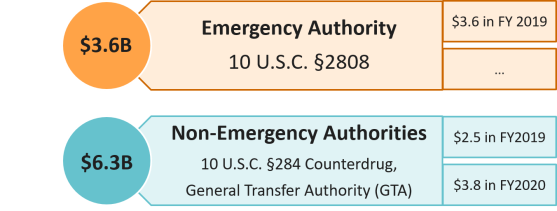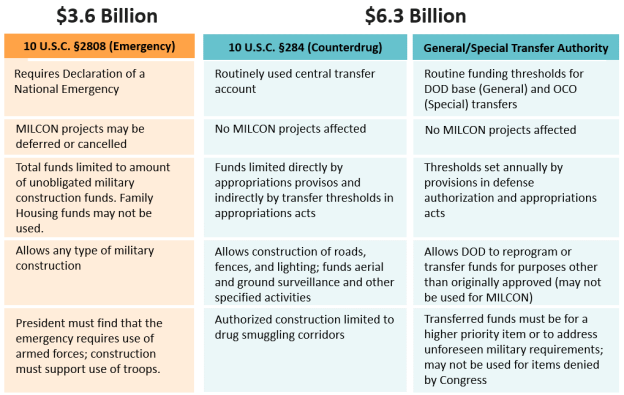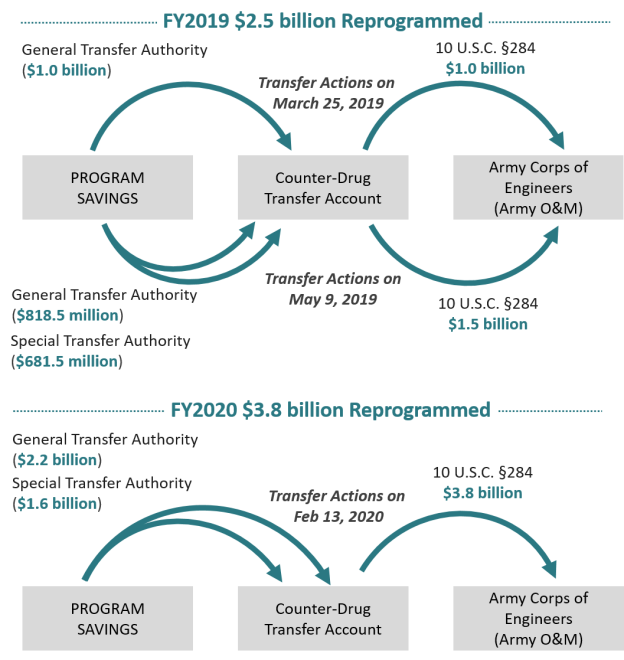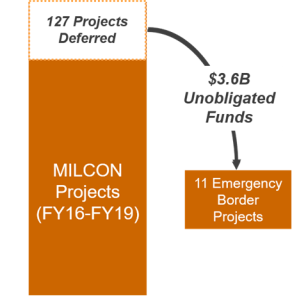FY2020 Defense Reprogrammings for Wall Funding: Backgrounder
On February 13, 2020, the Department of Defense (DOD) transferred $3.8 billion from defense procurement programs to the Army Operation and Maintenance account for use by the U.S. Army Corps of Engineers (USACE) for the construction of 31 additional barrier projects along the southern border of the United States.
Table 1. Summary of FY2020 DOD Reprogramming Action to Support the Border Wall
($ in thousands)
|
Base or OCO / Appropriation |
Amount |
Percentage |
|
Base |
$2,202,000 |
57.48% |
|
Aircraft Procurement, Air Force |
$532,000 |
24.16% |
|
Aircraft Procurement, Navy |
$558,000 |
25.34% |
|
Other Procurement, Army |
$201,000 |
9.13% |
|
Shipbuilding and Conversion, Navy |
$911,000 |
41.37% |
|
Overseas Contingency Operations (OCO) |
$1,629,000 |
42.52% |
|
Aircraft Procurement, Air Force |
$329,000 |
20.20% |
|
National Guard and Reserve Equipment |
$1,300,000 |
79.80% |
|
Total |
$3,831,000 |
100.00% |
Source: Under Secretary of Defense (Comptroller), Budget Execution, 20-01_RA_Support_for_DHS_Counter_Drug_Activity, February 13, 2020. Available at https://comptroller.defense.gov/Budget-Execution/ReprogrammingFY2020/.
Notes: Percentages shown as proportion of parent row total.
The transfers repeated, in part, a process the Department undertook twice in 2019 in conjunction with additional emergency construction transfers detailed below.
DOD Has Used Two Funding Streams to Support Construction of Border Barriers ($9.9 billion)
Since March 2019, the Administration has redirected approximately $9.9 billion from military construction projects and defense programs using two funding streams; one enabled by a combination of non-emergency authorities (10 U.S.C. §284 and General/Special Transfer Authority, or GTA/STA), and the other by the emergency construction authority 10 U.S.C. §2808. These separate funding streams are shown in Figure 1.
|
Figure 1. Defense Transfer Funding Streams the Administration has Used for Border Barrier Construction ($9.9 billion) |
 |
|
Source: CRS Analysis of reprogramming and transfer actions. Notes: The "…" in the empty FY2020 Emergency Authority box indicates additional actions may be expected, but DOD has not announced additional emergency transfers. Amount shown under Non-Emergency Authorities does not include an additional $161 million in operational costs from FY2019 and FY2020. |
Figure 2 compares the limits of each of the authorities associated with the separate funding streams.
|
Figure 2. Limits on Authorities the Administration has Used to Redirect Defense Funds for Border Barriers ($9.9 billion) |
 |
|
Source: CRS graphic based on analysis of identified statutes. Notes: Amounts do not include additional funds transferred for operational costs ($160 million). See Under Secretary of Defense (Comptroller), Reprogramming Action FY 19-35 IR (Sept. 27, 2019), FY 20-01 1R (Oct. 1, 2019), FY 20-10 IR (Jan. 28, 2020). See also CRS Report R46002, Military Funding for Border Barriers: Catalogue of Interagency Decisionmaking, by Christopher T. Mann and Sofia Plagakis. |
The following section provides background on how the Administration has used these authorities; first, the non-emergency 10 U.S.C. §284 counterdrug transfers (shown in blue in Figures 1 and 2), and 10 U.S.C. §2808 emergency transfers (shown in orange in Figures 1 and 2).
10 U.S.C. §284 Counterdrug Transfer Process ($6.3 billion)
In three separate reprogramming actions since March 2019, DOD has made $6.3 billion in defense appropriations available to the U.S. Army Corps of Engineers for border barrier construction.
Last year (CY 2019), these funds were transferred from FY2019 appropriations ($2.5 billion); they were generally related to unrealized military personnel costs (due to low Army recruitment) and Afghan Security Forces management efficiencies. This year, all of the reprogrammed funds ($3.8 billion) were drawn from FY2020 procurement items added by Congress during its deliberations on the President's defense budget request.
The process of moving funds from defense appropriations to the Army Operation and Maintenance Account for use by USACE involved several stages, each enabled by a different set of authorities (see figure below), although it was chiefly enabled by use of a counterdrug transfer account.
First, DOD reprogrammed funds into the counterdrug account using either General Transfer Authority (for base appropriations) or Special Transfer Authority (for overseas contingency operations, or OCO). Next, the Department used 10 U.S.C. §284 to transfer funds from the counterdrug account to Army O&M, for activities supporting counterdrug operations (border barrier construction).
DOD used this combination of reprogramming and transfer actions twice in 2019: first in March ($1 billion) and again in May ($1.5 billion). It repeated these actions again in February 2020 ($3.8 billion). See Figure 3.
 |
|
Source: Under Secretary of Defense (Comptroller), Reprogramming Action FY2019-01 RA (March 25, 2019), FY2019-02 RA (May 9, 2019), FY2020-01 RA (February 13, 2020). See also CRS Report R46002, Military Funding for Border Barriers: Catalogue of Interagency Decisionmaking, by Christopher T. Mann and Sofia Plagakis. |
10 U.S.C. §2808 Transfer Process ($3.6 billion)
In September 2019, DOD announced it would invoke 10 U.S.C. §2808 to defer 127 military construction projects and redirect $3.6 billion to 11 border barrier projects identified by DHS.
|
Figure 4. Administration's Use of 10 U.S.C. §2808 to Defer Military Construction Projects |
 |
|
Source: CRS analysis of 10 U.S.C. §2808 transfer actions. Notes: Military construction projects affected included those that received appropriations between FY2016-FY2019. |
When the President declares a national emergency requiring the use of the Armed Forces and invokes the emergency authority under 10 U.S.C. §2808, the Secretary of Defense is permitted to undertake construction projects "not otherwise authorized by law that are necessary to support such use of the armed forces." Such construction is funded using unobligated MILCON appropriations—effectively defunding previously approved military projects.
DOD developed the following criteria to identify military construction projects eligible for deferment under 10 U.S.C. §2808:
- No military housing projects.
- No projects that were already awarded a contract.
- No projects with projected award dates before FY2020.
The Department's final selection indefinitely deferred 127 previously authorized MILCON projects. Figure 5 below shows the distribution by location.
Issues for Congressional Consideration
In FY2020, Congress refrained from imposing new constraints on DOD transfers, allowing the Department to again undertake reprogramming actions to support border barrier construction; this was done over the objection of congressional committees with oversight jurisdiction and in violation of DOD regulations. As Congress deliberates on the FY2021 appropriations process, it will again face the precedent established by the Trump Administration for redirecting defense funds outside of the regular budgetary process.
